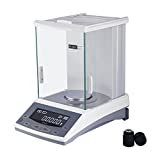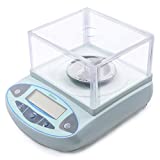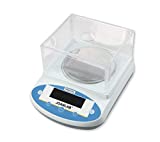Analytical balance scales – Buying guide & Comparison
If you’re short on time and you just want to find the best analytical balance scale, this short paragraph should help you get exactly the model you need. According to our findings/research, the U.S. Solid USS-DBS8 is the best analytical balance scale because it is a fully electronic device that ,measures weights ranging up to 200 grams, with 0.1 mg precision. You can easily read the measured weight using the convenient blue backlit LCD screen, for trouble-free viewing. Measuring units can be either carats or ounces to accommodate laboratory specifications. The cutting edge RS-232 interface allows linking with your computer to enable serial data exchange between the balance scale and your PC. The reliable draft shield effectively prevents inaccurate weighing when working with small quantities that can be affected by the slightest nuances in humidity or the breeze. If the U.S. Solid USS-DBS8 is unavailable, your second option should be the U.S. Solid USS-DBS3-3.
Comparison table
 Our Top Choice
Our Top Choice
This measuring scale is a nifty product which can detect a quantity that's in the sub-milligram range, meaning it is ideal for those who need precision in all types of fields. It can be used to measure the weight of any substance, and it will also allow you to convert the units into any system.
One reviewer pointed out that the device can’t weigh items that exceed 200 grams and that it doesn't feature a calibration certificate.
If you want something precise and easy to use, then this should be on your options list. You can use it in any environment without worrying about interference, and the LCD screen will be a lifesaver.
 2nd Best
2nd Best
One selling point of this analytical scale is its compact body, which will allow you to move it from one room to another with ease. It is lightweight, at only four pounds. The maximum capacity is 300 grams, and it runs on a dual power supply, AC or DC, which offers a lot of versatility.
As a complaint, this machine doesn't work well with recurrent calibration, as it will start to lose its accuracy by 0.2 grams in a few years.
When it comes to drawing the conclusions, we realize this model has something to offer to any user. It is high-quality and well made, and more important, portable and accurate to the extreme.
Also To Consider
Give a try to the main features of this item. It weighs in both grams and ounces, which is ideal especially for pharmacists and people who work in the chemical industry. It rocks an LCD screen and converting the scaling systems will be a breeze with the built-in features.
As one buyer pointed out, the machine is fantastic, but it can be limiting for those who want to weigh things that exceed the 1000-gram limit.
The bottom line is that this scale is complete from all points of view. It has many positive parts, like accuracy and the LCD screen, which will make repeated and subtle measurements much more enjoyable.
Able to read extremely small quantities between 0.01 mg (0.00001 g) and 1 mg (0.001 g), an analytical balance proves to be indispensable in the laboratory setting for interval weighing when connected to a PC with special software, differential weighing, density measurement, formulation weighing, pipette calibration, sample management as well as other analytical weighing applications. These are what separate the products featured in the best analytical balance scale reviews from the less stellar ones.
Capacity and calibration that suit the needs of your lab
The capacity of the analytical balance scale is a primary aspect to consider here. The first thing you want to know when looking into this element is how much would you actually need the instrument to weigh up to. It is pointless, for instance, to get a balance that weighs up to 300 grams if the items you measure are only up to 100 grams each. The capacity of the instrument should be high enough to handle what you want it to, with perhaps a tiny extra just in case, but do not go overboard to actually push the price spectrum higher than needed.
Some manufacturers offer different weighing capacity ranges, such as 1 to 250 grams and 250 to 500 grams for effortless selection. For small analytical measurements, the 1 to 250-gram weighing capacity range should be enough. You may also opt for either manual or automatic internal calibration. On the larger end of the weighing spectrum, go for analytical balances with a weighing capacity range of 250 to 500 grams or even up to 1000 grams, also with either automatic internal or manual calibration.
With automatic internal calibration, you enjoy convenience and time savings because of the easy readability and capacity, but cost may be a big issue. A lot of automatic internal calibration models also feature external calibration. Manual calibration, typical in a vintage analytical balance scale, involves the traditional placement of a certified calibration weight on the instrument and then manually entering the calibration mode of the device. The only issue with this type of calibration is the need to get the external weight recertified periodically to ensure correct calibration of the balance at all times.
Accuracy and suitable division size or resolution
When checking out the accuracy of an analytical balance, manufacturers often specify a combined maximum error of two divisions. Thus, when weighing out 100 grams of fine powder with an accuracy requirement of +/- 1 mg, using a balance with an increment size of 0.01g/10mg will not provide reliable sample weighing because you won’t be able to tell if the sample is short or in excess by 1 mg. That being said, a division size of 1 mg may give you a suitable reading but when the accuracy or maximum error of a balance is taken into account, you will still need a device with 0.1 mg readability or resolution. The cardinal rule is to get an analytical balance with as small an increment size as possible to ensure you are closer to the desired measurement. Naturally, the smaller the increment size, the costlier the instrument. The maximum difference between the displayed weight and the test weight determines the accuracy of the device.
The increment size, also known as the readability, division size or resolution, refers to the smallest unit the balance will display, so a 0.1 mg increment size will mean the display on the scale will increment by 0.1 mg. Do not mistake the increment size for accuracy. Get information on accuracy from the instrument datasheet.
Functionality and features to suit lab needs
An analytical balance with dynamic weighing is suitable for use with small animals. With internal calibration, you would simply need to press a button to calibrate the test weights instead of manually calibrating them. You will also have to decide on the units you will use for weighing, whether in ounces or grams, milligrams, troy ounces or grains, etc. An analytical balance with parts counting function allows you to keep track of the number of very small items you weigh to determine if the set of items or the single item is as specified. Some models come with statistical function. High-end models come with a number of application modes, adjustable angle displays, vibration filtering, user-programmable touchless sensors, well-designed graphical user interface, and true-type printing, making them extremely easy to use.
A draft shield prevents inaccuracies caused by small things such as vibrations, the room temperature, humidity and the breeze. An anti-vibration work surface may be needed for use with the instrument. A de-ionizer feature eliminates the static charge or any electrostatic issues when weighing plastic elements and other conductive items. The ability to interface with data logging software is useful for storing data on a computer. Some models are equipped with density determination kits, in-use covers for protecting the display, and traceable calibration certificates for quality measuring procedures.
5 Best Analytical Balance Scales (Reviews) in 2024
There are numerous analytical balances on the market. To help make your shopping experience smoother, refer to the buying guide above. For even more shopping assistance, the best products in this category are featured below.
Contents
1. Digital Analytical Balance Lab Precision Scale from U.S. Solid

Outfitted with a draft shield, this analytical balance will not allow errors to occur due to small things like room temperature, humidity or even the soft breeze during measurement procedures. The scale offers a weighing capacity up to 200 grams and a precision of 0.1 mg. Fully electronic, this balance scale enables easy measurement reading from its LCD screen with convenient blue backlight.
Switching between units of measure is easy, as this instrument allows you to go for either the metric system or the English system for carats or ounces. The RS-232 interface enables easy linking with your computer to accommodate serial data exchange between your PC and the analytical balance scale.
The 80mm stainless steel pan size provides enough room to accommodate various types of samples. Lightweight at only 7.2 kg, this instrument is powered via the AC 110-240V universal adaptor. Repeatability is ±0.1mg while Linearity is ±0.3mg.
Pros
This amazingly performant measuring scale is capable of sensing small differences in the sub-milligram range, allowing for high precision and countless uses in numerous industries.
Handling extremely small quantities, this product will be able to provide you with accurate information whenever you decide to weight an object on it.
You can switch between different unit measurements to easily convert these measurements whenever you want. Karats, ounces or the English metric system have never been more easily switched in-between than with this item.
The product itself is lightweight but does provide a sturdy outer case.
This balance scale spots a very bright LCD display with backlit for easy seeing while the pan is made from high-quality stainless steel.
Cons
It can only weigh items up to 200 grams so it may not be suitable for use in other areas than those with extreme precision.
The product is not shipped with a calibration certificate.
Buy from Amazon.com
2. Digital Analytical Balance Precision Scale for Laboratories

The instrument runs on either AC or DC power supply and has a maximum power consumption of just 3 watts so you can perform many weight measurements in a day without worrying about your utility bill. The instrument allows unit conversion from ounces to carats or grams to pounds to suit the needs of your laboratory. The unit features manual calibration and has a tare function to support accuracy in the lab.
It also has a parts count function so you know whether an item or a set of items comes up to specifications or standards.
Reading the measurements is easy thanks to the LCD Display with backlight. The level ball allows problem-free placement on the countertop. The draft shield prevents measurement errors due to changes in room temperature, humidity and other elements.
Pros
The product is extremely lightweight and easy to carry around, weighing only 2 kg.
The maximum weighing capacity is 300 grams, more than most of the products within the same price range offer.
It is extremely useful for measuring very low quantities of a certain product, with an accuracy of ±0.001 g.
It runs on a dual power supply, either on AC or DC, depending on your needs.
It allows unit conversions between different unit scales, from grams to ounces and karats to ensure the needs of your laboratory and test results. You can easily set the calibration manually at the beginning of each measurement.
This device is easy to use and comes at an extremely attractive price.
Cons
If you regularly switch the calibration, the interior algorithm of the product will begin showing measurement differences of as much as 0.2 grams per measurement, which is very much for a product within this price range.
Buy from Amazon.com
3. Ohaus 30429803 Pioneer Analytical Balance Internal Calibration

The stainless steel weighing pan ensures resistance to corrosion. The analytical balance offers a solid and durable construction in its scale sets and weighing pan for ease of use and effortless cleaning. Very easy to operate, the balance is equipped with a button or key switch design.
It also comes with a low power warning plus overload indication to ensure prompt charging and adjustment at all times. The scale comes with a standard RS232 interface for easy linking with your computer to allow serial data exchange between the balance scale and your PC.
The accuracy resolution is 0.01g. This is a self-calibrating device so you won’t have to worry about inaccuracies. It also has tare function to accommodate any nuances in procedures.
Pros
The product measures both in grams and ounces for an easy scaling and easily determining the right amount of a product you want to weight.
It features a bright double-sided LED screen display for easy reading and data gathering. You can now easily make the measurements you want and simply write down the data without having to convert between different scaling systems.
The product can be connected to your PC to allow serial data exchange between the scale and your computer.
It is sold for a very affordable price, so we suggest giving it a try.
Cons
The main downside of this rather good balance scale is that it can only weigh up to 1000 grams. Thus, the product is rather useless for larger scale weights and you will probably have to orient towards alternative items.
The instructions menu is poorly translated into English so you will probably have to think twice before using some of this item’s functions.
Buy from Amazon.com
4. Digital Analytical Balance Weighing Precision Lab Scale 110V

The scale has a weighing capacity from 0 to 200 grams, proving to be useful for measuring very small quantities. Reading of the measurement is easy thanks to the bright LCD screen with backlight.
The unit comes standard with a mains adapter/AC/DC transformer for use without plugging into an AC socket. The draft shield serves to protect measurements from errors due to small elements such as humidity, room temperature and the wind.
The unit also has height adjustable feet for easy countertop positioning. Choose from grams, ounces and carats as units of measure. The device has memory for accumulated time so you can keep track of your measuring processes. The unit has Readability of 0.1mg, Repeatability at ±2 mg and Linearity of ±1 mg to ensure accuracy.
Pros
Thanks to the easy and revolutionary RS232 interface this balance scale easily connects to your PC to allow free serial data transfer between these two items for convenient data gathering in real time.
It features a stainless steel pan highly resistant to corrosion which will last you for many years, even during heavy use.
The product has a weighing capacity of up to 200 grams, sufficient to perform weighings of various substances and products with high accuracy.
It is equipped with standard AC/DC transformer/ adapter to ensure sufficient power to run the product even without plugging it into an AC socket.
Cons
This is a professional balance scale mainly used for high-tech laboratories so it is only natural that it comes with a rather high listing price. If you plan on only using a scale for personal purposes, we do suggest looking for cheaper alternatives.
Buy from Amazon.com
5. Sartorius Entris124 1S Analytical Balance

With its black and white high contrast LCD, this analytical balance scale offers easy viewing of weighing results for hassle-free data collection and comparison.
The positive click action keys ensure easy use. Enjoy excellent readability, fast operation and easy navigation during your measurement procedures. The simple-to-read level indicator on the front allows easy placement on the laboratory countertop or work surface. This can be used for weighing small animals, for parts counting, density determination and conversion or percentage determination.
The top sliding door, side doors and removable stainless steel components of the draft shield chamber ensure hassle-free cleaning. Equipped with a monolithic weighing system, the scale delivers long-term weighing accuracy for years of use in the lab setting.
Pros
It features a black and white high contrast LCD for easy reading between different scales.
It ensures high accuracy of all the data sets, making it extremely suitable for lab and professional use. The weighing accuracy is of ±0.0001 grams.
It comes with a stainless steel pan that is resistant to corrosion and will protect the scale’s interior so you can benefit from hustle-free professional weighs for many years from now on.
The product has a user-friendly interface with fast operations and plenty of functions included to support your data gathering, counting, and conversion.
Cons
This is strictly a professional tool that has to be used under laboratory strict rules and regulations and may not be what you want for personal use. The high selling price is due to the complexity of the technology it features and will probably be much more than you expect to pay for a balance scale.
It only provides a maximum weighing of 120 grams, so you may want to look for alternatives should you want to weigh heavier samples or substances.
Buy from Amazon.com
Bibliography:
1) The use of an analytical balance
2) How to Use an Analytical Balance
3) What is an analytical balance used for?
4) Different types of balances
5) How can you maintain an analytical balance scale?












